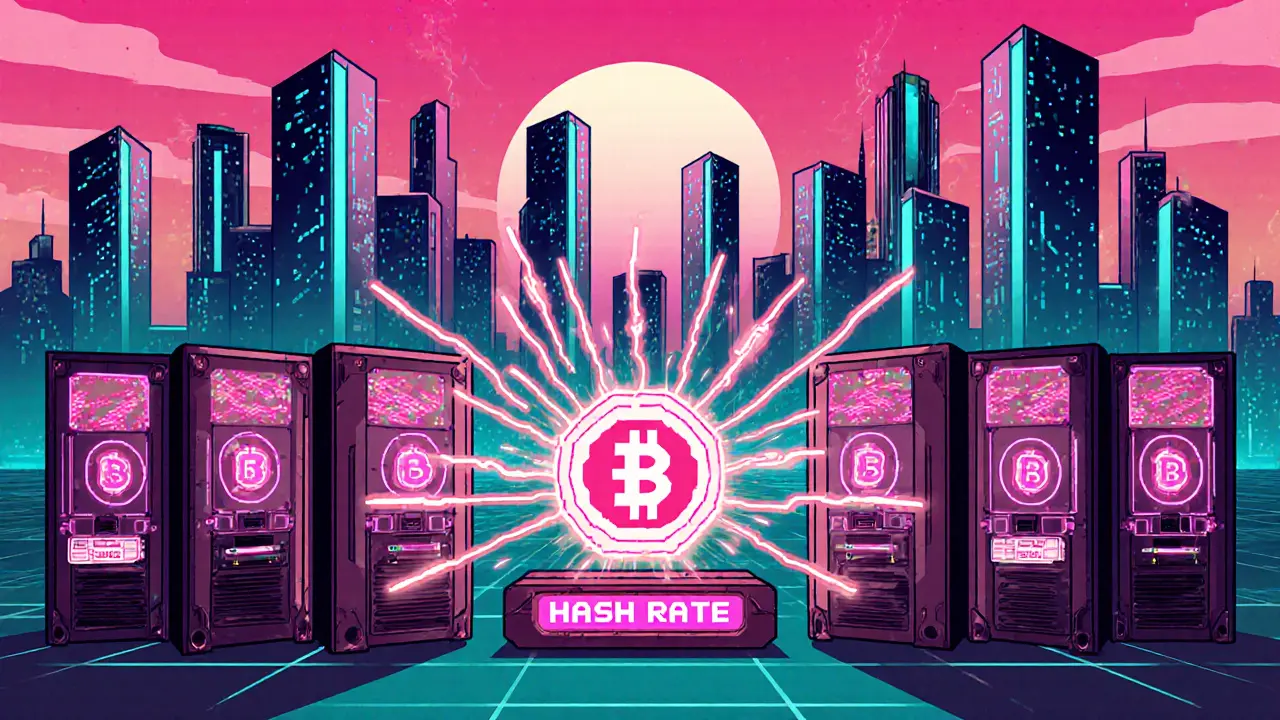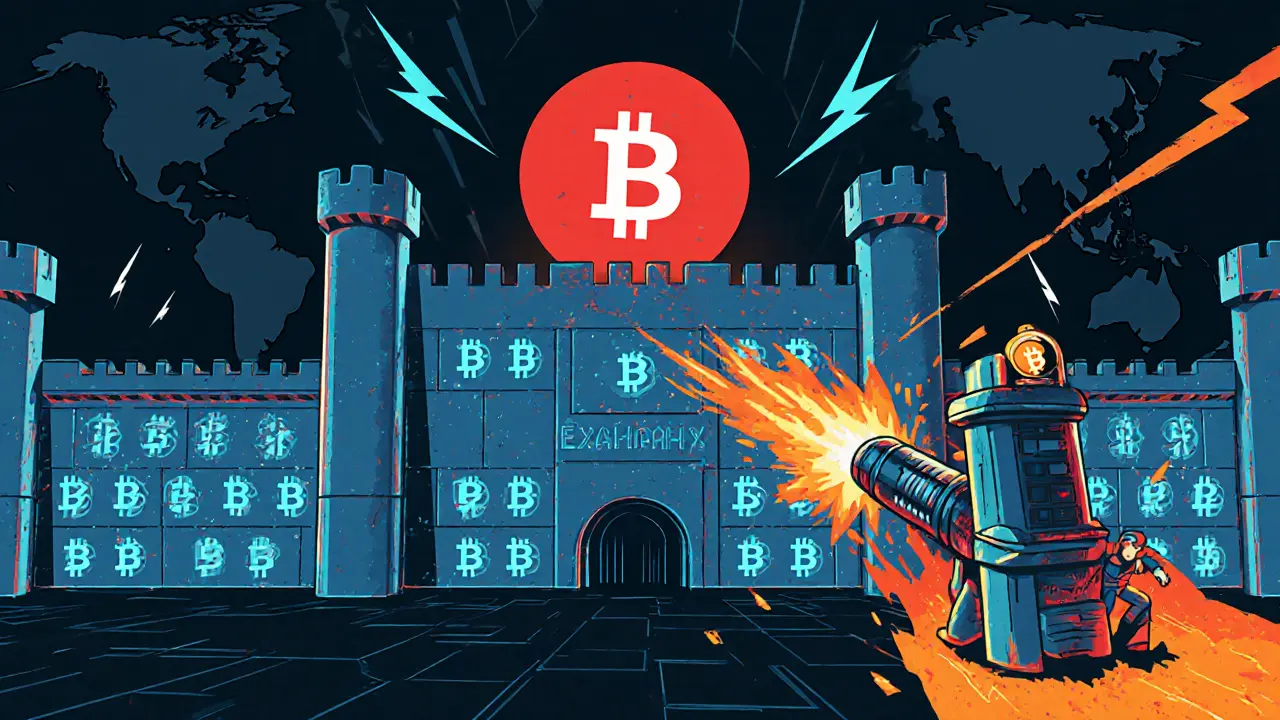Hash Rate Explained: What It Is and Why It Matters in Cryptocurrency
 Oct, 16 2025
Oct, 16 2025
Key Takeaways
- Hash rate measures how many hash calculations a network performs per second.
- Higher hash rate means stronger security but also higher energy use.
- Bitcoin leads with over 600 EH/s, while other PoW coins are far behind.
- Hardware, location, and pool concentration shape the overall hash rate.
- Monitoring tools and moving‑average charts help smooth out short‑term spikes.
What Is Hash Rate?
When discussing blockchain performance, Hash Rate is the total number of hashing calculations a cryptocurrency network performs each second. In plain English, it tells you how fast miners are guessing the right cryptographic puzzle to add a new block.
Because proof‑of‑work (PoW) miners compete to be the first to find a valid hash, the network’s combined computing power becomes a direct measure of its resistance to attacks. If you hear traders say “the hash rate is climbing,” they’re spotting a security boost.
How Is It Measured?
Hash rate is expressed in hashes per second (H/s) with common prefixes:
- 1 KH/s = 1,000 H/s
- 1 MH/s = 1 million H/s
- 1 GH/s = 1 billion H/s
- 1 TH/s = 1 trillion H/s
- 1 PH/s = 1 quadrillion H/s
- 1 EH/s = 1 quintillion H/s
The basic formula is simple: H/s = Total hashes ÷ Time. If a miner processes one billion hashes in one second, that rig is operating at 1 GH/s.
Why Hash Rate Matters for Security
Network security scales with hash rate because an attacker would need to control more than 50 % of the total computing power to rewrite history-a “51 % attack.” For Bitcoin’s current 600 EH/s, that translates to roughly $15 billion worth of top‑tier ASICs and massive electricity costs.
Higher hash rate also stabilizes block times. Bitcoin automatically adjusts mining difficulty every 2,016 blocks (about two weeks) to keep the average block interval at ten minutes, regardless of short‑term hash spikes or drops.

Hash Rate Across Major PoW Cryptocurrencies
| Cryptocurrency | Hash Rate | Typical Hardware |
|---|---|---|
| Bitcoin | ≈ 600 EH/s | Antminer S21 |
| Litecoin | ≈ 650 TH/s | Antminer L7 |
| Dogecoin | ≈ 450 TH/s | Antminer D15 |
| Bitcoin Cash | ≈ 4.2 EH/s | WhatsMiner M30S |
| Bitcoin SV | ≈ 1.8 EH/s | Antminer S19 |
Ethereum no longer appears here because it moved to proof‑of‑stake in 2022, eliminating the hash‑rate metric entirely.
Factors That Influence Network Hash Rate
Several variables push the hash rate up or down:
- Hardware innovation: New ASIC models (e.g., Antminer S21) bring higher TH/s per unit, raising the global total.
- Energy cost and availability: Cheaper electricity regions attract large farms, while regulatory bans (like New York’s PoW moratorium) shave off portions of the hash rate.
- Geographic concentration: Over 47 % of Bitcoin’s hash power comes from just three countries, creating jurisdictional risk despite the aggregate size.
- Mining pool dynamics: When a major pool switches providers, the network sees a temporary spike or dip that smooths out over a week.
- Difficulty adjustments: The protocol raises difficulty when hash rate climbs, keeping block times steady.
Monitoring and Using Hash Rate Data
For casual observers, a 7‑day moving average chart on Blockchain.com eliminates daily noise. Professional traders often pull real‑time APIs from Glassnode or CryptoQuant, then correlate hash rate trends with price movements.
Typical workflow:
- Pull the latest hash‑rate metric (in EH/s for Bitcoin).
- Apply a 7‑day moving average.
- Overlay the network difficulty line.
- Watch for divergence: a rising hash rate with falling price can hint at upcoming consolidation.
Remember that sudden “spikes” often stem from temporary pool migrations, especially around halving events.

Common Misconceptions & Risks
Many newcomers think a higher hash rate always equals a better investment. In reality, hash rate reflects network security, not price direction. A rapid rise could simply be new hardware rollout, while a drop might signal miners shutting down due to electricity price hikes.
Another myth: “If my personal rig hits 100 TH/s, I’m guaranteed profit.” Real‑world data shows hardware degradation (up to 20 % after two years) and variance in pool payouts can erode earnings quickly.
Future Outlook
Industry forecasts expect Bitcoin’s hash rate to breach 800 EH/s by early 2025, driven by more efficient ASICs and immersion‑cooling designs. However, centralization risks rise as the top ten pools now control over 78 % of the total power.
Alternative consensus models-proof‑of‑stake (Ethereum) and proof‑of‑space (Chia)-continue to attract environmentally conscious projects, but they sacrifice the brute‑force security that hash rate offers.
Frequently Asked Questions
What does “EH/s” stand for?
EH/s means exahashes per second, or one quintillion hash calculations each second.
Why did Ethereum’s hash rate disappear?
Ethereum switched from proof‑of‑work to proof‑of‑stake in September 2022, eliminating the need for mining and thus removing the hash‑rate metric.
How much does a 51 % attack cost on Bitcoin today?
Rough estimates place the cost around $15 billion, based on the price of top‑tier ASICs (e.g., Antminer S21 at $5,200 per 200 TH/s) and current electricity rates.
Can I use hash‑rate data to predict Bitcoin price?
Hash‑rate trends are a leading indicator of network health, but they’re not a direct price predictor. Many traders combine hash‑rate with difficulty and on‑chain activity for a fuller picture.
What’s the difference between hash rate and mining difficulty?
Hash rate is the actual speed of the network (hashes per second). Difficulty is a protocol‑set target that tells miners how hard it is to find a valid block; the network adjusts difficulty to keep block times stable as hash rate changes.
Peter Brask
October 23, 2025 AT 20:05Kyle Waitkunas
October 24, 2025 AT 00:08vonley smith
October 24, 2025 AT 23:45Melodye Drake
October 25, 2025 AT 02:10paul boland
October 26, 2025 AT 00:23